The ability of your property and the surrounding landscape to support a white-tailed deer population is largely influenced by the type of vegetation present and the land-use decisions being made about the area. Although white-tailed deer are very adaptable animals, they do have essential requirements of food, cover and water, the first two of which are provided throughout the year by a mixture of plant communities (Figure 1).
Woodland and forest are terms that are often used interchangeably but that actually describe distinct natural communities. Woodlands are characterized as having tree coverage with 30 to 80 percent closure in the canopy, or overstory — the uppermost layer in a stand of trees; a sparse midstory; and diverse herbaceous vegetation made up of forbs and grasses at ground level, or understory. Woodlands that are more open with widely spaced trees, areas often called savannas, support a larger percentage of fire-tolerant trees, such as post, burr and black jack oaks. As a result of frequent disturbances, such as prescribed fires, a greater diversity of early successional vegetation exists at the ground layer of open woodland stands (Figure 2). True forests, as opposed to woodlands, typically have a closed tree canopy. Forest stands are made up of multiple layers of trees in the canopy and species of shade-adapted shrubs and saplings in the mid- and understories. They also contain more fire-sensitive trees and shrubs — such as white oak, northern red oak, sugar maple and American hornbeam — than woodlands (Figure 3).
Fortunately, forestry and wildlife management are not mutually exclusive, and practices that are conducted for timber production can also benefit a variety of wildlife species. This publication describes woodland and forest management practices that can benefit white-tailed deer in particular.
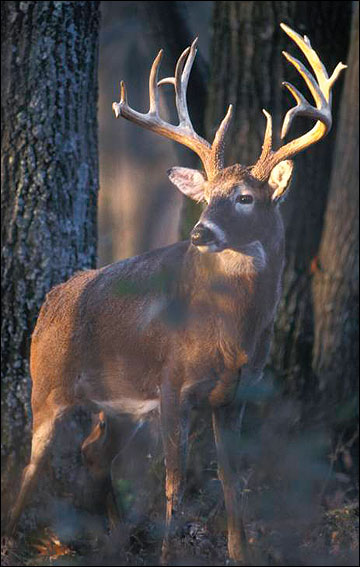 Figure 1
Figure 1
White-tailed deer use a variety of successional stages of plants, including woodland and forest habitats, for food and cover.
 Figure 2
Figure 2
The increased sunlight reaching the ground in open woodlands stimulates the growth of vegetation that provides ample forage and cover for deer.
 Figure 3
Figure 3
Forests are denser than woodlands and consist of multiple layers of trees in the canopy, with saplings and shrubs in the midstory.
Deer and forest succession
Sound timber management strategies that create a mixture of plant successional communities also improve white-tailed deer habitat. Diversity is the key.
Undisturbed, a plant community gradually advances from bare soil to hardwood forest in a process called ecological succession. After a disturbance, such as a timber harvest or a prescribed fire, a plant community initially develops annual and perennial plants, such as grasses, forbs and legumes. These species respond to the increased sunlight and bare soil conditions. Over time shrubs and small trees — such as blackberry, sassafras, sumac and dogwood — begin to grow. Their presence modifies the site conditions and promotes the development of later stages of plant succession that include species such as oaks and hickories. Openings within a forest stand provide excellent sources of browse and forage, and more mature stands of hardwoods produce hard and soft mast, such as acorns and persimmons, respectively, that white-tailed deer use during the fall and winter.
Several management practices can be conducted within forests and woodlands to ensure that cover and food are available throughout the year. Because acorns are an especially important food and energy source for white-tailed deer during the fall and winter, it is important to conduct management practices that favor a diversity of oaks, including both red and white oak species, as well as soft-mast producing trees and shrubs. Practices such as a timber stand improvement (TSI) or a planned commercial harvest can create conditions that favor a diversity of mast-producing trees, promote the regeneration of highly valued oak species, and produce an abundance of high-quality browse as well as shrubby cover beneficial to deer.
Creating and maintaining transition zones between forest or woodland tracts and adjacent fields can also contribute to habitat diversity. A transition zone between two cover types is often called an edge. White-tailed deer and many other wildlife species are attracted to edges because the food and cover they require can be found in close proximity in these areas. These transition zones can be created and enhanced through a variety of management practices, such as timber stand improvement, edge feathering and field border enhancement. Each of these practices adds diversity to the landscape.
Management of woodlands and forests for deer
Harvesting, thinning, creating woodland openings, conducting a prescribed fire, and forest regeneration activities alter the quantity and quality of deer forage and cover. Any management activity that opens the tree canopy and allows more sunlight to reach ground level will stimulate the growth of herbaceous and shrubby plants, increasing the amount of forage. Management activities that encourage a diversity of mast-producing trees, such as combinations of red and white oaks, are also beneficial. Each of these goals can be accomplished by using a silvicultural system, that is, a process of manipulating the forest stand, that results in either an even-aged or uneven-aged stand of trees on the area.
Even-aged management systems
Even-aged management is a preferred method for establishing shade-intolerant trees species such as red and white oaks and shortleaf pine. This management system results in the regeneration of a new stand of trees that are all about the same age, hence the term even-aged. Three harvest systems that result in an even-aged stand are clearcuts, seed-tree cuts and shelterwood cuts.
Clearcuts
Clearcutting is the removal of all trees from a tract in a single harvest operation to regenerate the stand (Figure 4a). The new stand of trees develops from either stump sprouts or seedlings that have been waiting in the understory for their chance to grow (Figure 4b). Depending on the circumstances and surrounding landscape, clearcuts can improve deer habitat in several ways:
- Regenerating important oak trees species that need full sunlight for seed germination and development
- Promoting early successional vegetation for five to seven years after harvest
- Creating a mixture of forest conditions within an area, encouraging a diversity of habitats beneficial for deer
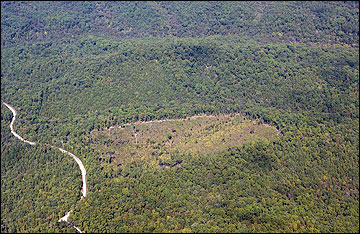 Figure 4a
Figure 4a
In the clearcut shown in the center of this aerial photo, all the trees were harvested and a new crop of trees is in the process of regenerating the stand.
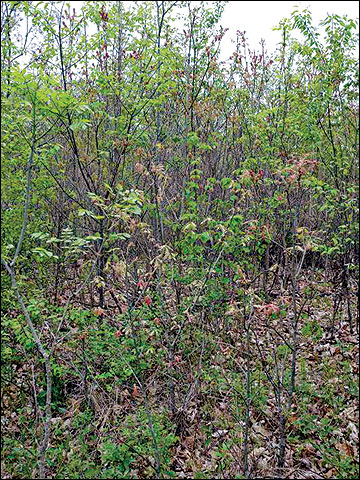 Figure 4b
Figure 4b
The vegetation growth that occurs after a clearcut provides excellent browse and cover for deer.
Seed-tree and shelterwood cuts
The seed-tree and shelterwood systems both leave crop trees scattered throughout the area to provide a source of seed for regeneration of the stand (Figure 5). Once the new seedlings are established, the seed trees may be harvested or left to grow until the next harvest.
The seed-tree technique involves harvesting all but a select few seed-producing trees. In general, one should leave, per acre, 10 to 15 trees with good crowns capabale of producing an abundant crop of acorns to establish the next forest.
The shelterwood technique leaves more crop trees standing after a harvest, and the new stand is established in partial shade. Generally, about 30 to 60 percent of the existing trees are removed during the first shelterwood cut. Then after the new stand is established, the remaining trees are harvested.
Both techniques allow more sunlight to reach the forest floor, stimulating the germination of annual plants and new growth of browse. In addition, the open conditions create a favorable environment for oaks and other shade-intolerant species to grow and successfully compete within the stand.
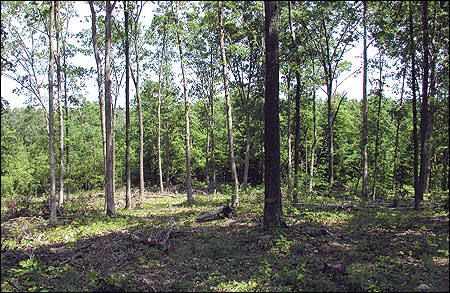 Figure 5
Figure 5
Crop trees are left during shelterwood and seed-tree cuts to promote the regeneration of the harvested area.
Uneven-aged management systems
Uneven-aged management results in a stand of trees of many ages and sizes. Typically, few trees are harvested at any one time, thus a tree canopy continuously shades the forest floor, favoring shade-tolerant species, such as maple, hornbeam, elm and dogwood. Two harvest systems that result in an uneven-aged stand are single-tree selection and group selection.
Single-tree selection
The single-tree selection system creates and maintains an uneven-aged stand. Each tree in the stand is evaluated independently, and individual trees are harvested as they mature. This method can also be used to recruit young oak seedlings into the forest stand. One approach that has been used successfully is to remove trees that compete with and are of lower quality, due to form or disease, than the higher quality crop trees. This approach results in the retention of better growing stock and thus an increase in the number and quality of crop tree over time.
Usually, single-tree selection does not promote the regeneration of large numbers of beneficial oaks. However, being in the transition zone between the eastern deciduous forest and the prairies of the Great Plains, Missouri’s forests and woodlands are drier and harsher than their eastern counterparts. As a result, later-successional tree species, such as sugar maple, that require moister growing conditions are unable to grow and develop, leaving oak and hickory to reproduce and flourish.
Group selection
In a group selection system, small groups of trees are harvested, creating small openings, which are essentially small clearcuts, within the stand. Harvesting small groups of trees allows more sunlight to reach the forest floor, encouraging the growth of early successional vegetation and resulting in an increased abundance of sprouts, shrubs, grasses and herbaceous vegetation, all of which benefit white-tailed deer (Figure 6). Group selection is well suited for small woodlots where occasional harvests are recommended. This system produces excellent habitat for white-tailed deer by promoting openings with abundant forage and browse and maintaining quality mast-producing oaks within the stand.
In summary, single-tree selection limits the regeneration of oak and other shade-intolerant species because of increased shading by the overstory and the resulting competition from shade-tolerant species, especially on tracts of land with a north and east aspect. This limitation is often less of an issue on lands with drier south and west aspects. In addition, group selection can be incorporated with single-tree selection to recruit oak regeneration. This practice will also provide the edge and early successional habitat lacking when single-tree selection is used.
 Figure 6
Figure 6
A group-selection timber harvest encourages the growth of an abundance of early successional vegetation, including shrubs and sprouts.
Other management practices beneficial for deer
Timber stand improvement
Timber stand improvement (TSI) is an intermediate treatment in the regeneration of a forest stand. Treatments are made to improve the composition, structure, condition, health and growth of a stand of timber. TSI practices can also be used to thin the forest stand by removing undesirable trees to favor more desirable trees, such as healthy oaks and hickories. This thinning produces numerous timber and wildlife benefits. By allowing more sunlight to reach the forest floor, it increases timber growth, stimulates greater oak regeneration and promotes growth of deer forage (Figure 7). It also gives the remaining trees more room to grow, resulting in larger tree crowns and increased acorn production.
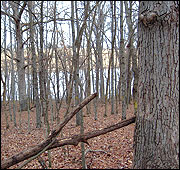
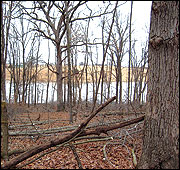

Figure 7
As illustrated in this series of photos of a timber stand (left to right) before being thinned and the first and third years after thinning, timber stand improvement practices open the forest canopy and allow more sunlight to reach the forest floor, stimulating the growth of plants that provide forage for deer.
Creating openings in a forest or woodland
Large tracts of forests or woodlands may lack the habitat diversity favored by white-tailed deer. Creating small openings within these stands can increase forage quantity and plant diversity. Generally, five to 10 small (1 to 5 acre) openings or clearings per 100 acres of woods are desirable when managing land for white-tailed deer. Two types of forest openings can be created: temporary and permanent.
Temporary forest openings, often called group openings, are essentially small clearcuts created in a forest to provide early successional forest habitat for wildlife. Temporary openings promote the growth of sprouts, shrubs, grasses and herbaceous vegetation (Figure 8). These areas also encourage the regeneration and growth of shade-intolerant species, such as valuable red and white oaks. Forest openings can be created by cutting and dropping all trees and brush in select areas of 3 to 5 acres each within larger contiguous blocks of forest. To be most beneficial, openings should be irregular-shaped to provide increased edge habitat and should be scattered throughout the property.
Although not usually considered a forest management practice, permanent openings can be created and planted to a perennial food plot or left in early successional herbaceous vegetation (Figure 9a). The size and shape of these openings depends on the property’s topography, but openings are most beneficial if at least 3 acres and irregular-shaped to provide more edge for wildlife (Figure 9b). Ideally, permanent openings should be created on the top of ridges or flat areas to minimize erosion.
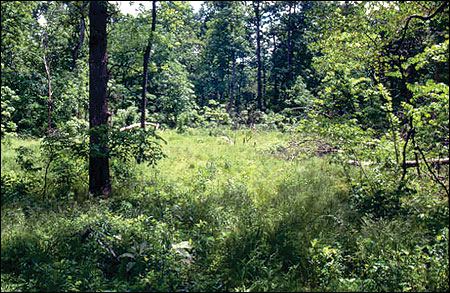 Figure 8
Figure 8
Temporary openings in a forest stand promote not only habitat diversity but also oak regeneration, which leads to greater acorn production.
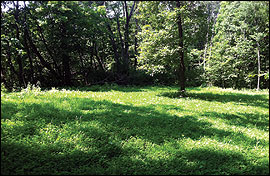
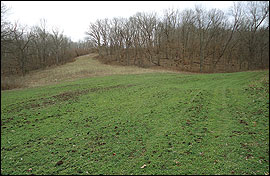
Figure 9
Permanent openings can be created within a forest stand to provide habitat diversity. These areas can be planted to a cool- or warm-season food plot to provide supplemental forage for deer.
Improving forest edge
The transition zone of vegetation between forests or woodlands and adjacent crop fields or pastures, often referred to as an “edge,” can provide valuable habitat for white-tailed deer. These areas are often characterized by an abrupt change from forest to field (Figure 10a). Edges can be improved by encouraging a gradual transition of plant types between the forest and field with a technique called edge feathering (Figure 10b) or by establishing a field border. Thinning or cutting trees near the edge of a woodland tract or adjacent to logging roads or right of ways can also create transition zones between habitat types (Figure 11). Trees more than 15 feet tall that are within 15 feet of the adjacent field can be cut or girdled (Figure 12). Treat all cut stumps, except eastern red cedar, with an approved herbicide to prolong the benefits of edge feathering. Always read and follow chemical labels for proper rates, usage and disposal. Each of these edge feathering techniques can be used to promote the growth of soft mast-producing trees, shrubs and vines that deer use for food and cover.
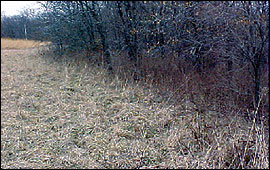
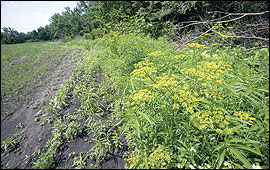
Figure 10
Many wildlife species benefit from edge habitats, but not all edges are created equal. An abrupt edge (a) provides little wildlife value, whereas a feathered edge (b) provides greater diversity and important vegetation that enhances the food and cover value for many wildlife species, including deer.
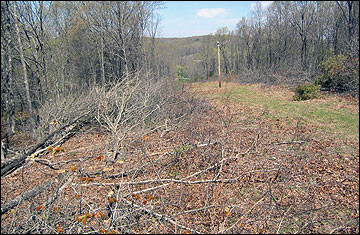 Figure 11
Figure 11
Edge feathering practices can be conducted within forests and woodlands to create transition zones of habitats that are beneficial for deer.
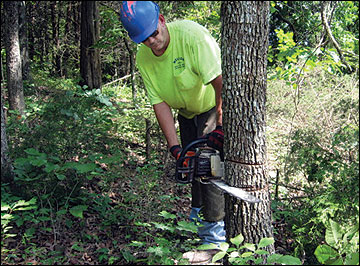 Figure 12
Figure 12
To thin trees near the edge of a woodland tract, cut or girdle them and treat them with a herbicide.
Prescribed fire
Prescribed fire is a management practice used to set back plant succession and control undesirable woody sprouts (Figure 13). Fire can be used set back succession within old fields, glades, woodlands, and hardwood and pine forests to enhance conditions for wildlife. Burning consumes the leaf litter layer in the forest, which in turn protects the stand from wildfire and stimulates the seed bank. Burn results are greatly influenced by the amount of light able to penetrate the canopy and reach the forest floor. Generally, conducting a prescribed fire after the stand has been thinned to about 60 percent canopy coverage is best for white-tailed deer and other wildlife. Low-intensity prescribed fires can be used on south- and west-facing slopes to improve deer habitat by stimulating new woody and herbaceous vegetation. Any thinnings or commercial harvests should avoid leaving logging slash at the base of trees that remain in the stand. To avoid this damage, be sure to use directional felling or to manually move tree tops from the base of these trees. Salable timber is usually found on the higher quality sites on north- and east-facing slopes, and prescribed fire should be excluded from those areas. Conducting prescribed burns during the dormant season (November through March) will also reduce damage to commercial sawtimber and future growing stock.
Compared to other techniques to increase forage, prescribed fire is far less expensive and much more efficient. Before conducting a prescribed fire, be sure to get a burn plan from a certified wildlife biologist or a Missouri Department of Conservation (MDC) private land conservationist. These plans typically include a plan map, burn objectives, areas of concern, and fire personnel to call in case of an emergency. Prescribed fire classes are also offered to landowners interested in improving their knowledge of fire as a management tool and increasing their comfort level using it.
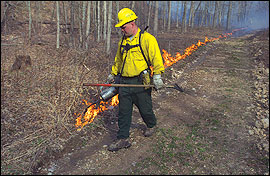
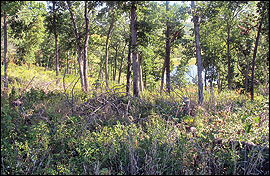
Figure 13
Conducting a prescribed fire (a) is an efficient and economical way to promote early successional habitat within a forest stand (b).
Developing a forest and wildlife management plan
A forest and wildlife management plan will help you identify practices that will provide the greatest benefit for white-tailed deer on your property. The goals that you set for the condition of your woodland or forest will dictate the overall quality of the habitat it provides for deer.
To successfully develop a plan, begin by conducting an inventory of the woodland habitat types on your property and the surrounding landscape. An aerial photograph of your property offers a complete look at the land uses and vegetative cover on your property and adjacent lands. This bird’s-eye view can help you understand the potential of your land for white-tailed deer and how you can improve it. Using the photo, you can identify forest stands, edge habitats, open areas, pastures and water sources, and evaluate their arrangement on your property and surrounding land. You will also need to get out on the property to determine the species, age, health and overall condition of the trees within individual tracts.
For help developing a forest and wildlife management plan, contact an MDC private land conservationist or forester or an MU Extension forestry or wildlife specialist.
Conclusion
Woodlands and forests in Missouri provide valuable habitats that white-tailed deer use throughout the year. Various management practices can be implemented to achieve your overall objectives within these habitats. Due to the relatively small size of most privately owned woodland tracts, few owners may have the luxury of managing timber stands that accommodate all the needs of white-tailed deer. Therefore, you should also consider the habitat components in adjoining stands or tracts, the timber species most suited to a given site, and the habitats that are most limiting, or in short supply, for deer across the landscape. Working with adjoining landowners with common goals can help ensure that the essential requirements of food, cover and water are available for the deer in the area. MU Extension publication G9492, Enhancing White-tailed Deer Habitats on Your Property: Evaluating Habitat, provides some guidelines on methods you can use to evaluate and improve your woodlands and other habitat types for white-tailed deer. An MDC private land conservationist (http://mdc.mo.gov/contact-us) or your local MU Extension Center can provide more information and technical guidance about woodland and forest management practices and the most appropriate techniques to use based on your situation and management objectives. For more information on managing white-tailed deer on your property, refer to the MU Extension publication series listed online at https://extension.missouri.edu/programs/wildlife-ecology-and-management/managing-for-white-tailed-deer.
Additional information
- Palmer, Bruce. 2007. Forest management for Missouri landowners. Jefferson City: Missouri Department of Conservation. http://mdc.mo.gov/sites/default/files/resources/2010/05/5574_3489.pdf
- Pitts, David E., and William D. McGuire. 2000. Wildlife management for Missouri landowners. Jefferson City: Missouri Department of Conservation. http://mdc.mo.gov/sites/default/files/resources/2010/05/5354_3245.pdf
- Heiligmann, Randall B. 2006. Herbicides commonly used for controlling undesirable trees, shrubs and vines in your woodland. Columbus: Ohio State University Extension. http://ohioline.osu.edu/for-fact/pdf/0045s.pdf
- Johnson P.S., S.R. Shifely, and R. Rogers. 2009. The ecology and silviculture of oaks. 2nd edition. Wallingford, UK: CAB International.